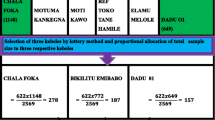Abstract
This paper examines the attitudes of circumcised women towards female circumcision in a community where the practice is in vogue. Also described are the type of circumcision performed, who usually performs the circumcision and complications. One hundred volunteers across the social strata were interviewed by means of a structured questionnaire. Data were analysed using frequency tables. The study revealed that 62% of respondents favoured the practice as an instrument for the control of female sexuality and maintenance of cultural pride. Circumcision is mainly by excision of the clitoris and the labia minora performed mainly by traditional birth attendants (TBAs). Complications include severe pain, difficulty with urination and excessive bleeding. Based on the findings, it is suggested that communities where femal genital mutilation (FGM) is practised as a social norm should be involved in any eradication campaign, with the support of national and international organisations. Research is also essential to understand FGM in order to design effective reforms.
Similar content being viewed by others
References
Dorkenoo, E. and Elsworthy, S. (1992). Female genital mutilation: proposals for change.London Minority Rights,43.
Hosken, F.P. (1993).The Hosken Report: Genital and Sexual Mutilation of Females, 4th rev. edition, Women’s International Network News, Lexington, Massachusetts.
Toubia, N. (1993).Female Genital Mutilation. A Call For Global Action, Women Link, New York.
Lightfoot-Klein, H. (1989).Prisoners of Ritual: An Odyssey into Female Genital Circumcision in Africa, Harrington Park Press, New York.
World Health Organisation (1986). A traditional practice that threatens health—female circumcision.WHO Chronicle 40(1), 31–36.
Baasher, T.A. (1977).Psychological Aspects of Female Circumcision, WHO Eastern Mediterranean Region.
Arbesman, M., Kahler, and Buck, G.M. (1993). Assessment of the impact of female circumcision on the gynaecological, genitourinary and obstetrical health problems of women from Somalia: literature review and case studies.Women and Health 20(3), 27–42.
United Nations Children Fund (1994).Guidelines for UNICEF Action on Eliminating Female Genital Mutilation, memorandum from James P. Grant, Executive Director (unpublished).
Calder, B.L. and Brown, T.M. (1993). Female circumcision/genital mutilation: culturally sensitive care.Health Care for Women International 14(3), 227–238.
Lightfoot-Klein, H. and Shaw, E. (1991). Special needs of ritually circumcised women patients.Journal of Obstetrics and Gynaecology, and Neonatal Nursing 20(2), 102–107.
Armstrong, S. (1991). Female circumcision fighting a cruel tradition.New Scientist 1754, 42–47.
Dorkenoo, E. (1995). WHO (Female Genital Mutilation). Personal communication 25 October and 20 December.
Black, T.A. and Debelle, G.D. (1995). Female genital mutilation in Britain.British Medical Journal 310(6994), 1590–1592.
Gallard, C. (1995). Female genital mutilation in France.British Medical Journal 310(6994), 1592–1593.
Hosken, F.P. (1995). Woman’s International News. Legal status of FGM in various countries. Personal communication.
Modupe, O.O. and Lola, V.A. (1985). Female circumcision in Nigeria: a fact or farce?Journal of Tropical Pediatrics 31, 180–184.
Slack, A.T. (1988). Female circumcision: a critical appraisal.Human Rights Quarterly 10, 437–486.
Hicks, E.K. (1993). Infibulation.Female Mutilation In Islamic Northeastern Africa, Transaction Publishers, New Brunswick, New Jersey.
Assaad, M.B. (1980). Female circumcision in Egypt. Social implications, current research and prospects for change.Studies in Family Planning 11(1), 3–16.
El Saadawi, N. (1980).The Hidden Face of Eve: Women in the Arab World, Bacon Press.
World Health Organisation and International Federation of Gynaecology and Obstetrics Task Force (1992). C female circumcision: female genital mutilation.European Journal of Obstetrics and Gynaecology and Reproductive Biology 45(2) 153–154.
Ntiri, D.W. (1993). Circumcision and health among rural women of Southern Somalia as part of a family life survey.Health Care for Women International 14(3), 215–226.
Dirie, M.A. and Lindmark, G. (1991). Female circumcision in Somalia and women’s motives.Acta Obstetricia et Gynaecologica Scandinavica 70(7–8), 581–585.
World Health Organisation (1982).Female Circumcision Statement of WHO Position and Activities (unpublished).
United Nations Population Fund (1995). Population award. Eyeing the prize.Populi 22(3), 5.
US Agency for International Development (1995).USAID’s Approach to Female Genital Mutilation, USAID, Washington DC.
United Nations (1994).Report of the International Conference on Population and Development, 5–13 September, Cairo, (preliminary version), UN, New York.
Inter-African Committee (1995). Ghana legislation against FGM. (Abstracted from IAC Newsletter). In, R.P. Hosken (ed.),Women’s International Network News 21(3), 38.
Mohamud, A. (1992).Female Genital Mutilation: A Continuing Violation of the Human Rights of Young Women, ICAF/Passages.
Toubia, N. (1995). (RAINB) (Female genital mutilation). Personal communication, 5 October and 12 December.
Ladjali, I.M. and Toubia, N. (1990). Female circumcision: desperately seeking a space for women.IPPF Medical Bulletin 24(2), 1–2.
Mohamud, A. (1995). (PATH) (Female genital mutilation). Personal communication.
Population Action International (1994).Questions and Answers on Female Genital Mutilation (information page) (unpublished).
Gilbert, D. (1993). Female genital mutilation: for the sake of purity (and control).Links 9(5), 6–8.
Rich, S. (1995). (Wallace Global Fund) (Female genital mutilation). Personal communication, 16 October.
McSwiney, M.M. and Saunders, P.R. (1992). Female circumcision: a risk factor in postpartum haemorrhage.Journal of Postgraduate Medicine 38(3), 136–137.
Eltahawy, M. (1995).Egyptian Rights Activists Sue Over FGM, Reuters Ltd (Compulserve News Service).
Ghalwash, M. (1995).Egypt—FGM, Associated Press (Compulserve News Service).
Ezzat, D. (1995). Female genital mutilation: promise compromised.Populi 22(5–6), 4–5.
Kiragu, K. (1995). Female genital multilation: a reproductive health concern.Population Reports Supplement, Meeting the Needs of Young Adults, Series J. 41(XXIII), 3.
Author information
Authors and Affiliations
Rights and permissions
About this article
Cite this article
Briggs, L.A. Female circumcision in nigeria: Is it not time for government intervention?. Health Care Anal 6, 14–23 (1998). https://doi.org/10.1007/BF02678072
Issue Date:
DOI: https://doi.org/10.1007/BF02678072




